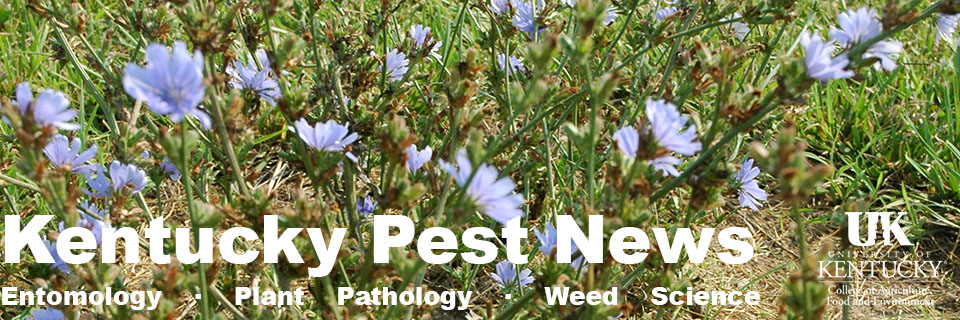Farmers are annually concerned about corn disease, and this year will be no exception. Corn growth stages in Kentucky vary widely, with some corn likely to tassel this week, while in other parts of Kentucky, corn is still in the bag and yet to be planted. The challenges to the 2024 planting season will make foliar disease monitoring and management decisions more important as the summer progresses.
Anthracnose & Gray Leaf Spot
Frequent rainfall across the state has led to some detections of anthracnose leaf blight (caused by Colletotrichum graminicola), and some low levels of gray leaf spot (caused by Cercospora zeae-maydis) in the lower canopy of corn that is close to tasseling. To date, no concerning levels of disease have been observed, but it is important to scout frequently, monitor University resources, and be prepared to act if conditions warrant foliar disease management. In most cases, a single foliar fungicide application at tasseling/silking (VT/R1) will be most effective at preventing yield loss due to foliar diseases, and it also provides the greatest chance of seeing a positive return on investment.
Southern Rust
One of the most important corn diseases to monitor in Kentucky is southern rust. The fungus that causes southern rust does not overwinter in Kentucky, but spores of the fungus move north on wind currents and weather each summer. You can track the movement of southern rust by watching the map on the cornipmpipe website. On the map, red counties/parishes indicate that southern rust has been confirmed by university/Extension personnel. To date, southern rust has been confirmed in Louisiana and Georgia. Southern rust typically arrives in Kentucky in mid-July, and whether a fungicide will be needed to manage southern rust at that time will depend on the crop growth stage at the time it is detected in an area. Fungicide applications may be needed to manage southern rust through the milk (R3) growth stage. More information on southern rust can be found here.
Tar Spot
Another disease that can be monitored on the cornipmpipe website is tar spot. Tar spot is a new disease in Kentucky, with only a handful of counties having confirmed disease since 2021. In all cases, tar spot was not observed until mid-September and did not impact yield. This is a disease of concern in states to the north, and you can monitor real-time confirmations here. Tar spot has been detected in a few northern states as of June 10. More information on tar spot can be found on the Crop Protection Network (CPN).
Fungicide Application Considerations
If considering a fungicide application in 2024, remember to scout fields first and check hybrid resistance ratings prior to fungicide application. Hybrids that are moderately resistant or resistant to foliar diseases (like gray leaf spot) are less likely to demonstrate an economic response to fungicide application.
Because of the variation in corn growth stages, and detections of important diseases in other states, farmers may be tempted to alter their planned fungicide application timings. Multiple foliar fungicide application timings are promoted in corn, but research at the University of Kentucky and in other states has shown that a fungicide application at tasseling/silking (VT/R1) is most effective at preventing yield loss due to foliar diseases, and it also provides the greatest chance of seeing a positive return on investment. Early foliar fungicide applications that occur at V4-V6 are less likely to provide an economic gain. See this related article on the CPN website.
Another popular application timing in Kentucky is a pre-tassel application that occurs between V10 and V14. University of Kentucky research has indicated that this application timing can provide comparable disease control and yield response to a VT/R1 application in a year with average disease pressure.
Scouting over the next few weeks and just prior to tasseling can help determine if fungicide applications are needed. Although disease levels will continue to build over the course of the season, University research indicates that foliar fungicides applied at tasseling or early silking (VT-R1) provide optimal foliar disease control for diseases like gray leaf spot compared to applications that occur earlier or later in the season. For southern rust, a fungicide application may be needed through milk (R3). Management of tar spot will be on a case-by-case basis at this time. Always check with your county agent for updates on the diseases present in your specific county and help determining if management is warranted.
By Kiersten Wise, Plant Pathology Extension Specialist
